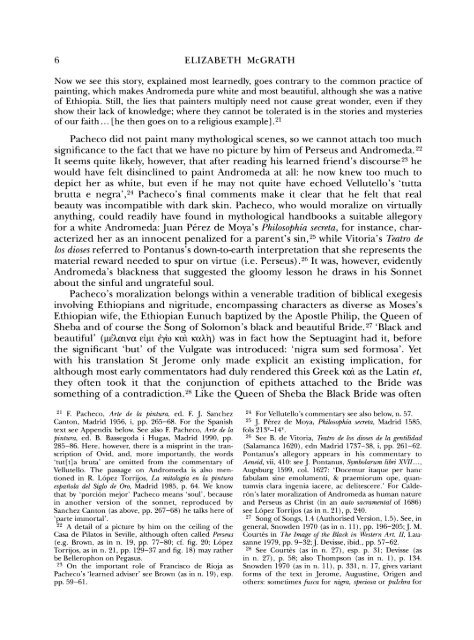The black andromeda.pdf - camberwellmastudents
The black andromeda.pdf - camberwellmastudents
The black andromeda.pdf - camberwellmastudents
You also want an ePaper? Increase the reach of your titles
YUMPU automatically turns print PDFs into web optimized ePapers that Google loves.
6 ELIZABETH McGRATH<br />
Now we see this story, explained most learnedly, goes contrary to the common practice of<br />
painting, which makes Andromeda pure white and most beautiful, although she was a native<br />
of Ethiopia. Still, the lies that painters multiply need not cause great wonder, even if they<br />
show their lack of knowledge; where they cannot be tolerated is in the stories and mysteries<br />
of our faith... [he then goes on to a religious example] .21<br />
Pacheco did not paint many mythological scenes, so we cannot attach too much<br />
significance to the fact that we have no picture by him of Perseus and Andromeda.22<br />
It seems quite likely, however, that after reading his learned friend's discourse23 he<br />
would have felt disinclined to paint Andromeda at all: he now knew too much to<br />
depict her as white, but even if he may not quite have echoed Vellutello's 'tutta<br />
brutta e negra',24 Pacheco's final comments make it clear that he felt that real<br />
beauty was incompatible with dark skin. Pacheco, who would moralize on virtually<br />
anything, could readily have found in mythological handbooks a suitable allegory<br />
for a white Andromeda: Juan Perez de Moya's Philosophia secreta, for instance, characterized<br />
her as an innocent penalized for a parent's sin,25 while Vitoria's Teatro de<br />
los dioses referred to Pontanus's down-to-earth interpretation that she represents the<br />
material reward needed to spur on virtue (i.e. Perseus).26 It was, however, evidently<br />
Andromeda's <strong>black</strong>ness that suggested the gloomy lesson he draws in his Sonnet<br />
about the sinful and ungrateful soul.<br />
Pacheco's moralization belongs within a venerable tradition of biblical exegesis<br />
involving Ethiopians and nigritude, encompassing characters as diverse as Moses's<br />
Ethiopian wife, the Ethiopian Eunuch baptized by the Apostle Philip, the Queen of<br />
Sheba and of course the Song of Solomon's <strong>black</strong> and beautiful Bride. 27 'Black and<br />
beautiful' (tikatva Eipt mi was in fact how the<br />
ccy0 K(ak)<br />
Septuagint had it, before<br />
the significant 'but' of the Vulgate was introduced: 'nigra sum sed formosa'. Yet<br />
with his translation St Jerome only made explicit an existing implication, for<br />
although most early commentators had duly rendered this Greek<br />
ia't as the Latin et,<br />
they often took it that the conjunction of epithets attached to the Bride was<br />
something of a contradiction.28 Like the Queen of Sheba the Black Bride was often<br />
21 F. Pacheco, Arte de la pintura, ed. F. J. Sanchez<br />
Canton, Madrid 1956, i, pp. 265-68. For the Spanish<br />
text see Appendix below. See also F. Pacheco, Arte de la<br />
pintura, ed. B. Bassegoda i Hugas, Madrid 1990, pp.<br />
285-86. Here, however, there is a misprint in the transcription<br />
of Ovid, and, more importantly, the words<br />
'tut[t]a bruta' are omitted from the commentary of<br />
Vellutello. <strong>The</strong> passage on Andromeda is also mentioned<br />
in R. L6pez Torrijos, La mitologia en la pintura<br />
espaiiola del Siglo de Oro, Madrid 1985, p. 64. We know<br />
that by 'porci6n mejor' Pacheco means 'soul', because<br />
in another version of the sonnet, reproduced by<br />
Sanchez Canton (as above, pp. 267-68) he talks here of<br />
'parte immortal'.<br />
22 A detail of a picture by him on the ceiling of the<br />
Casa de Pilatos in Seville, although often called Perseus<br />
(e.g. Brown, as in n. 19, pp. 77-80; cf. fig. 20; L6pez<br />
Torrijos, as in n. 21, pp. 129-37 and fig. 18) may rather<br />
be Bellerophon on Pegasus.<br />
23 On the important role of Francisco de Rioja as<br />
Pacheco's 'learned adviser' see Brown (as in n. 19), esp.<br />
pp. 59-61.<br />
24 For Vellutello's commentary see also below, n. 57.<br />
25 J. P6rez de Moya, Philosophia secreta, Madrid 1585,<br />
fols 213v-14'.<br />
26 See B. de Vitoria, Teatro de los dioses de la gentilidad<br />
(Salamanca 1620), edn Madrid 1737-38, i, pp. 261-62.<br />
Pontanus's allegory appears in his commentary to<br />
Aeneid, vii, 410: see J. Pontanus, Symbolarum libri XVII...,<br />
Augsburg 1599, col. 1627: 'Docemur itaque per hanc<br />
fabulam sine emolumenti, & praemiorum ope, quantumvis<br />
clara ingenia iacere, ac delitescere.' For Calder6n's<br />
later moralization of Andromeda as human nature<br />
and Perseus as Christ (in an auto sacramental of 1686)<br />
see L6pez Torrijos (as in n. 21), p. 240.<br />
27 Song of Songs, 1.4 (Authorised Version, 1.5). See, in<br />
general, Snowden 1970 (as in n. 11), pp. 196-205;J. M.<br />
Courte s in <strong>The</strong> Image of the Black in Western Art. II, Lausanne<br />
1979, pp. 9-32;J. Devisse, ibid., pp. 57-62.<br />
28 See Courtes (as in n. 27), esp. p. 31; Devisse (as<br />
in n. 27), p. 58; also Thompson (as in n. 1), p. 134.<br />
Snowden 1970 (as in n. 11), p. 331, n. 17, gives variant<br />
forms of the text in Jerome, Augustine, Origen and<br />
others: sometimes fusca for nigra, speciosa or pulchra for



